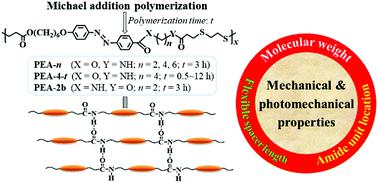当前位置:
X-MOL 学术
›
Polym. Chem.
›
论文详情
Our official English website, www.x-mol.net, welcomes your
feedback! (Note: you will need to create a separate account there.)
Enhancing the performances of physically cross-linked photodeformable main-chain azobenzene poly(ester-amide)s via chemical structure engineering
Polymer Chemistry ( IF 4.1 ) Pub Date : 2022-05-31 , DOI: 10.1039/d2py00492e Yan Zhou 1 , Lei Wang 1 , Huiqi Zhang 1
Polymer Chemistry ( IF 4.1 ) Pub Date : 2022-05-31 , DOI: 10.1039/d2py00492e Yan Zhou 1 , Lei Wang 1 , Huiqi Zhang 1
Affiliation

|
The synthesis of a series of photodeformable main-chain azobenzene (azo) poly(ester-amide)s (PEAs) with different flexible spacer lengths, molecular weights, and amide unit location via Michael addition polymerization and study of the correlation between their chemical structures and performances are first described. These PEAs showed low crystallinity degrees and glass transition temperatures, high thermal stability, reversible photoresponsivity, and amide unit-induced hydrogen bonding interactions. Their chemical structures exhibited a large influence on their film-forming capability as well as mechanical and photomechanical properties. Physically cross-linked uniaxially oriented fibers and films with high mechanical strength and reversible room-temperature photoinduced bending/unbending behaviors were fabricated from high-molecular-weight PEAs with a flexible spacer (–(CH2)n–) between the amide unit and azo mesogen (PEA-n), whereas their low-molecular-weight counterpart and PEA with the amide unit directly connected to the azo mesogen (PEA-2b) only formed brittle fibers/films. The mechanical strength of PEA-n fibers/films increased with the increase in the molecular weights and flexible spacer length, whereas optimal photomechanical effects were observed for PEA-n samples with a moderate molecular weight and a shorter flexible spacer (n = 2). The photomobile rates and amplitudes of PEA fibers/films can be well correlated with their elastic moduli and photoinduced stress. In addition, the decisive role of the aggregation states of PEA samples in their mechanical strength as well as those of both the amide unit-induced physical cross-linking and alignment structure in their photomobility was also demonstrated. This work not only presents photodeformable main-chain azo PEAs with enhanced performances via chemical structure engineering, but also lays the foundation for rationally designing more advanced physically cross-linked photomobile main-chain azo polymers.
中文翻译:

通过化学结构工程提高物理交联光致变形主链偶氮苯聚(酯-酰胺)的性能
一系列具有不同柔性间隔长度、分子量和酰胺单元位置的光致变形主链偶氮苯(偶氮)聚(酯-酰胺)(PEA )首先描述了迈克尔加成聚合及其化学结构和性能之间的相关性研究。这些 PEA 显示出低结晶度和玻璃化转变温度、高热稳定性、可逆光响应性和酰胺单元诱导的氢键相互作用。它们的化学结构对其成膜能力以及机械和光机械性能有很大影响。具有高机械强度和可逆室温光致弯曲/不弯曲行为的物理交联单轴取向纤维和薄膜由高分子量 PEA 制成,在酰胺单元和偶氮介晶(PEA -n),而它们的低分子量对应物和具有直接连接到偶氮介晶(PEA-2b)的酰胺单元的PEA仅形成脆性纤维/薄膜。PEA -n纤维/薄膜的机械强度随着分子量和柔性间隔长度的增加而增加,而对于具有中等分子量和较短柔性间隔( n= 2)。PEA 纤维/薄膜的光移动速率和振幅与其弹性模量和光致应力密切相关。此外,还证明了 PEA 样品的聚集状态对其机械强度的决定性作用,以及酰胺单元诱导的物理交联和排列结构对其光迁移性的决定性作用。该工作不仅通过化学结构工程提出了具有增强性能的光致变形主链偶氮PEA,而且为合理设计更先进的物理交联光移动主链偶氮聚合物奠定了基础。
更新日期:2022-05-31
中文翻译:

通过化学结构工程提高物理交联光致变形主链偶氮苯聚(酯-酰胺)的性能
一系列具有不同柔性间隔长度、分子量和酰胺单元位置的光致变形主链偶氮苯(偶氮)聚(酯-酰胺)(PEA )首先描述了迈克尔加成聚合及其化学结构和性能之间的相关性研究。这些 PEA 显示出低结晶度和玻璃化转变温度、高热稳定性、可逆光响应性和酰胺单元诱导的氢键相互作用。它们的化学结构对其成膜能力以及机械和光机械性能有很大影响。具有高机械强度和可逆室温光致弯曲/不弯曲行为的物理交联单轴取向纤维和薄膜由高分子量 PEA 制成,在酰胺单元和偶氮介晶(PEA -n),而它们的低分子量对应物和具有直接连接到偶氮介晶(PEA-2b)的酰胺单元的PEA仅形成脆性纤维/薄膜。PEA -n纤维/薄膜的机械强度随着分子量和柔性间隔长度的增加而增加,而对于具有中等分子量和较短柔性间隔( n= 2)。PEA 纤维/薄膜的光移动速率和振幅与其弹性模量和光致应力密切相关。此外,还证明了 PEA 样品的聚集状态对其机械强度的决定性作用,以及酰胺单元诱导的物理交联和排列结构对其光迁移性的决定性作用。该工作不仅通过化学结构工程提出了具有增强性能的光致变形主链偶氮PEA,而且为合理设计更先进的物理交联光移动主链偶氮聚合物奠定了基础。











































 京公网安备 11010802027423号
京公网安备 11010802027423号